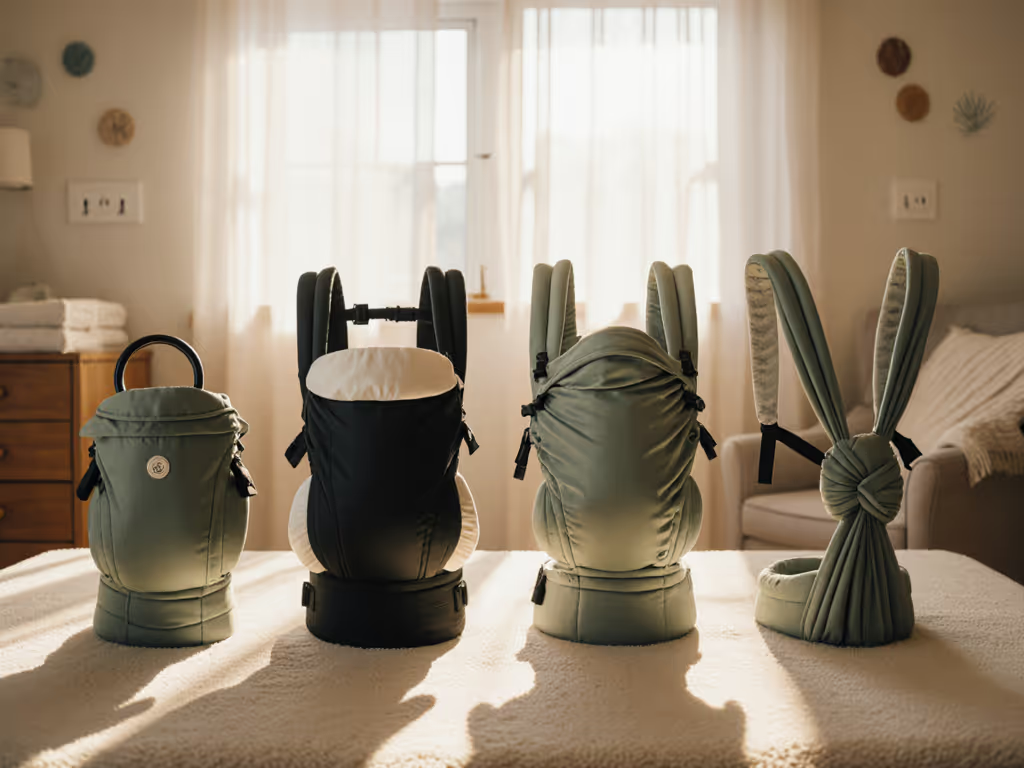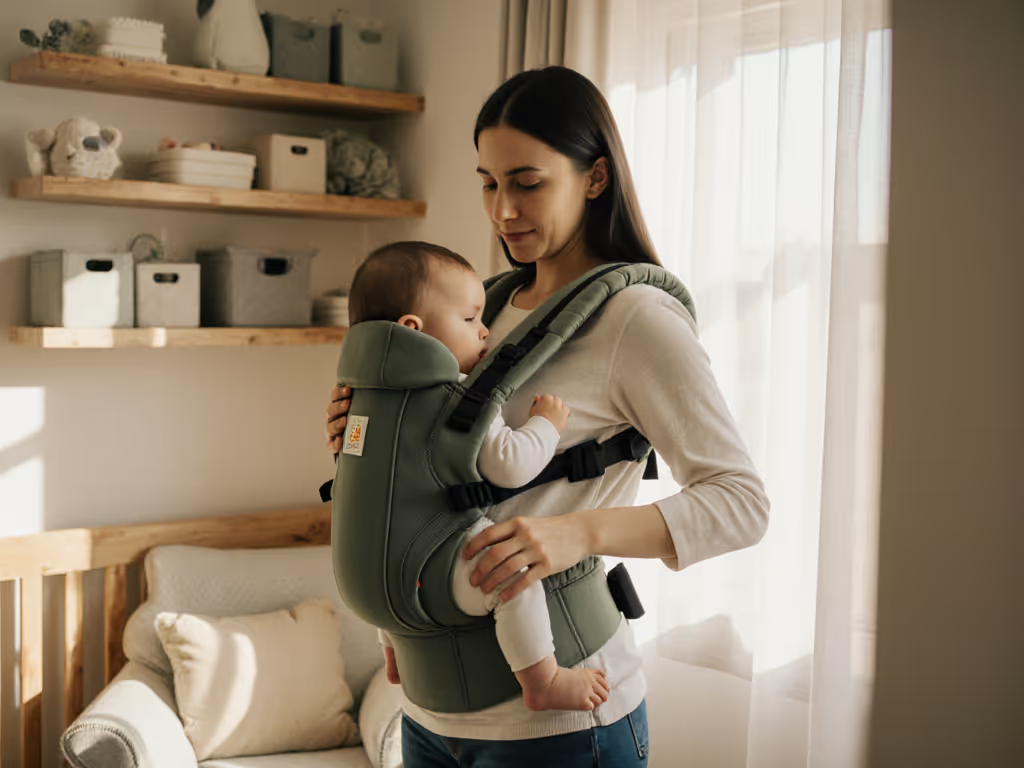
7 Top Babywearing Tips 2025 for Safe and Comfy Carrying

Over 90 percent of new parents admit to struggling with baby carrier comfort and safety in the first year. The right carrier supports your body and protects your baby, yet so many options make choosing a challenge. Learning what matters most in fit and design can save you from discomfort, awkward moments, and even potential injury. This guide helps you spot the key features and practical tips that lead to a safer, more confident babywearing experience.
Quick Summary
| Takeaway | Explanation |
|---|---|
| 1. Choose the right carrier design for your body type. | Select a carrier that fits your physique to ensure comfort and support for both you and your baby. |
| 2. Conduct a fit check before each use. | Perform a quick inspection looking for tears and ensuring straps are secure to maintain safety while wearing your baby. |
| 3. Ensure proper hip and neck support for your baby. | Position your baby in a natural sitting posture to support their developing joints and provide necessary head and neck support. |
| 4. Dress both caregiver and baby appropriately for the climate. | Use breathable layers and monitor temperatures to avoid overheating or chilling during outdoor activities. |
| 5. Stay informed about updated safety guidelines. | Regularly check recommendations from pediatric organizations and stay updated on best practices for babywearing safety. |
1. Choose the Right Carrier for Your Body and Baby
Selecting the perfect baby carrier transforms your parenting experience from challenging to comfortable. Your carrier needs to fit not just your baby but also your unique body shape and lifestyle.
The right carrier provides crucial support for both you and your little one. Every parent's body is different. What works perfectly for a tall, athletic person might feel completely uncomfortable for someone with a smaller frame. Your carrier should distribute weight evenly across your back and shoulders to prevent strain and potential injury.
When choosing a carrier, consider these key factors:
- Body Type: Match the carrier design to your physique
- Baby's Age and Weight: Different carriers suit different developmental stages
- Comfort Level: Prioritize your physical comfort during extended wear
- Activity Type: Select a carrier that supports your daily movements
Physical comfort translates directly into better bonding time with your baby. A well-fitted carrier allows you to keep your child close while maintaining your freedom of movement. Whether you are running errands, doing household chores, or taking a walk, the right carrier becomes an extension of your body.
Pro tip: Always test carriers before purchasing. Many baby stores offer fitting sessions where experts can help you find the most suitable option for your specific needs. Your comfort and your baby's safety are the top priorities in this selection process.
2. Check Carrier Fit Before Each Use
Baby carrier safety starts with a meticulous pre use fit check every single time you prepare to wear your little one. Skipping this quick inspection could put your baby at unnecessary risk.
Carrier safety is not a one time setup but a continuous commitment. Professional organizations like the Baby Safety Foundation recommend thorough carrier checks before each use to prevent potential accidents. Babies grow quickly and carriers can experience subtle stretching or wear that might compromise their structural integrity.
Here are key steps for a comprehensive carrier fit check:
- Visual Inspection: Look for any visible tears or loose threads
- Strap Adjustment: Ensure all straps are secure and symmetrical
- Weight Distribution: Confirm the carrier supports your baby evenly
- Buckle and Clip Functionality: Test all attachment mechanisms
A proper fit means your baby sits high on your chest with their face visible and airways clear. Their position should mimic a natural seated posture with knees higher than their bottom creating an ergonomic "M" shape. When done correctly your carrier transforms from a simple fabric wrap to a secure mobility solution that keeps your baby safe and comfortable.
Remember: A 30 second pre use check can prevent potential mishaps and give you peace of mind during your babywearing adventures.
3. Ensure Proper Hip and Neck Support
Your baby's physical development depends critically on correct positioning during babywearing. Proper hip and neck support is not just about comfort but about preventing potential long term health issues.
Healthy hip alignment is fundamental for your baby's skeletal growth. Medical professionals emphasize the importance of maintaining a natural "M" shaped leg position that supports proper hip joint development. This means your baby's knees should be higher than their bottom creating a spread squat position that prevents unnecessary strain on developing joints.
Key considerations for optimal support include:
- Head Position: Always keep your baby's head upright and face visible
- Spine Alignment: Ensure a natural curved position that supports their developing spine
- Knee Placement: Position legs in a frog like spread squat configuration
- Airway Clearance: Maintain an open breathing pathway
Newborns especially require extra attention. Their neck muscles are not fully developed so you must provide consistent head and neck support. A good carrier should allow your baby to rest in a natural position where their head is supported and their chin is not pressed against their chest which could restrict breathing.
Pro tip: Regularly check your baby's position and comfort. A happy baby with proper support will remain calm and engaged during your shared adventures.
4. Dress Baby and Caregiver for the Local Climate
Babywearing transforms your connection with your little one while navigating changing weather conditions. Smart clothing choices keep both you and your baby comfortable and safe during your shared adventures.
Temperature regulation is a critical aspect of babywearing that many parents overlook. Babies cannot regulate their body temperature as effectively as adults so your clothing strategy becomes their primary protection against environmental changes.
Key strategies for climate appropriate babywearing include:
- Layer Wisely: Use thin breathable layers for both baby and caregiver
- Check Contact Points: Monitor areas where your body directly touches the baby
- Avoid Overheating: Watch for signs of excessive warmth like sweating or flushed skin
- Adjust Quickly: Be prepared to add or remove layers as temperatures shift
In cooler environments consider wearing a larger jacket that can zip around both you and your baby creating a shared warmth zone. During warmer weather opt for lightweight moisture wicking fabrics that allow air circulation. The goal is maintaining a consistent comfortable temperature without causing your baby to become too hot or too cold.
Remember that your body heat significantly impacts your baby so dress slightly lighter than you normally would. A good rule of thumb is to add one less layer to your baby than you are wearing to prevent overheating.
5. Practice Safe Baby Positioning Every Time
Baby positioning is not a one time setup but a continuous commitment to your child's safety and comfort during babywearing. Every single time you use a carrier you must carefully check your baby's position.
Professional childcare experts recommend following the T.I.C.K.S. rule for consistent safe positioning. This memorable acronym breaks down critical safety checks that protect your baby during carrier use.
Key components of safe positioning include:
- Tight: Carrier should be snug with no loose fabric
- In View: Baby's face must always be visible
- Close Enough to Kiss: Keep baby high on your chest
- Keep Chin Off Chest: Prevent potential breathing restrictions
- Supported Back: Maintain natural spine curvature
Newborns require extra attention because their neck muscles are not fully developed. Their positioning directly impacts breathing and overall comfort. When positioned correctly your baby will feel secure and you will feel confident knowing they are safe.
Remember that safe positioning is not just about following rules. It is about creating a secure environment where your baby can rest comfortably while staying connected to you. Practice makes perfect so take time to learn and adjust your technique with each wearing session.
6. Regularly Inspect Carrier for Wear and Tear
Your baby carrier is more than just a piece of fabric. It is a critical safety tool that requires consistent maintenance and vigilant inspection to protect your most precious cargo.
Carrier integrity matters more than most parents realize. Small signs of wear can quickly transform a reliable carrier into a potential safety risk. Fabric stress points like seams and attachment areas can weaken over time especially with frequent use and repeated washing.
Key areas to examine during your carrier inspection include:
- Fabric Condition: Check for thin spots or small tears
- Strap Strength: Test all weight bearing straps for fraying
- Buckle Functionality: Ensure clasps lock and release smoothly
- Seam Quality: Look for loose threads or separation
- Elastic Components: Verify stretch and resilience remain intact
Consider creating a monthly inspection routine where you thoroughly examine your carrier under good lighting. Run your hands along all surfaces feeling for unexpected rough patches or weak points. Think of this process like a car maintenance check but for your baby transportation system.
Pro tip: If you notice any compromise in the carrier structure replace it immediately. No amount of repair can guarantee the same level of safety as a new carrier designed to protect your child.
7. Stay Informed on Latest Safety Guidelines
Parenting requires continuous learning and babywearing safety is no exception. The landscape of child safety recommendations evolves rapidly with new research and technological advancements.
Knowledge is your most powerful parenting tool. Baby carrier safety guidelines are not static but dynamic recommendations that reflect emerging research about infant development and ergonomic best practices. Staying current means actively seeking out reliable information from reputable sources.
Strategies for staying updated include:
- Follow Pediatric Organizations: Track recommendations from professional health associations
- Subscribe to Safety Newsletters: Receive direct updates from carrier safety alliances
- Attend Parenting Workshops: Learn from certified childcare professionals
- Join Online Parent Communities: Share and receive current safety insights
- Review Manufacturer Updates: Check for recent carrier safety modifications
Professional organizations like the Baby Carrier Industry Alliance regularly release updated safety protocols. These guidelines reflect advancements in understanding infant physiology and carrier design. By dedicating just a few hours each year to education you can significantly enhance your babywearing safety knowledge.
Remember that being an informed parent means being proactive. Your commitment to learning translates directly into better protection for your most precious cargo.
This table provides a comprehensive summary of the main considerations and steps for ensuring safe and comfortable babywearing from the article.
| Topic | Description | Key Considerations |
|---|---|---|
| Choosing the Right Carrier | Select a carrier that fits both parent and baby comfortably, considering body type, baby’s age, and lifestyle. | Distribute weight evenly; test before purchase. |
| Carrier Fit Check | Perform pre-use safety checks every time to prevent risks. | Inspect for tears, secure straps, and test clasps. |
| Hip and Neck Support | Ensure proper baby positioning for healthy development. | Maintain "M" shape, spine support, open airways. |
| Dressing for Climate | Dress both baby and caregiver appropriately for weather. | Layer wisely, avoid overheating; adjust as needed. |
| Safe Positioning | Follow the T.I.C.K.S. rule to secure baby safely. | Keep snug fit, face visible, maintain supported back. |
| Carrier Maintenance | Regularly inspect carriers for wear to maintain safety. | Check fabric, straps, buckles; replace if worn. |
| Staying Informed | Keep updated with the latest safety guidelines. | Follow updates from pediatric and safety organizations. |
Discover Safer and More Comfortable Babywearing Today
The challenges of finding the perfect baby carrier that supports both your body and your baby are very real. From ensuring proper hip and neck support to performing a quick fit check before each use, the details make all the difference in your baby's safety and your comfort. You want peace of mind knowing your baby is snug in a carrier that suits your unique body type and the local climate while preventing strain and promoting healthy development.
At Caregiver Carry, we understand these crucial needs. Our platform offers detailed guides, safety checklists, and unbiased reviews designed to help you choose the best carrier for your lifestyle. Whether you need help with safe baby positioning or want to stay informed on the latest guidelines, our expert resources are here to support your journey. Don't wait until a small oversight puts your baby at risk. Take charge of your babywearing safety now by exploring our step-by-step instructions for safe positioning and in-depth buying guides to find the right fit exactly for you.
Start creating safer, more comfortable babywearing moments today by visiting Caregiver Carry. Your baby deserves nothing less.
Frequently Asked Questions
How do I choose the right baby carrier for my body type and lifestyle?
Choosing the right baby carrier involves considering your body type and daily activities. Match the carrier design to your physique, and find one that distributes weight evenly to prevent strain. Test carriers by visiting baby stores for fitting sessions before buying.
What should I check before using my baby carrier each time?
Before each use, conduct a fit check to ensure safety and comfort. Look for visible tears, ensure all straps are secure, and confirm that your baby is positioned correctly for optimal support. Aim to spend no more than 30 seconds on this quick inspection.
How do I ensure my baby has proper hip and neck support in the carrier?
To provide proper hip and neck support, ensure your baby is positioned in a natural 'M' shape with knees higher than their bottom. Maintain their head upright and visible, while checking that their airway is clear. Regularly adjust their position as they grow to promote healthy development.
What clothing strategies can help with babywearing in different weather conditions?
Dress both yourself and your baby in thin, breathable layers to regulate temperature effectively. Check for signs of overheating and be prepared to adjust layers as needed. A good rule of thumb is to dress your baby in one less layer than you are wearing to avoid excessive warmth.
What does the T.I.C.K.S. rule entail for safe baby positioning?
The T.I.C.K.S. rule outlines critical checks for safe positioning: keep the carrier tight, ensure your baby's face is in view, hold them close enough to kiss, keep their chin off their chest, and support their back. Follow these guidelines each time you use the carrier for optimal safety and comfort.
How can I regularly inspect my baby carrier for wear and tear?
Implement a monthly inspection routine for your baby carrier, checking for fabric condition, strap strength, and buckle functionality. Look for signs of wear like fraying or tears, and replace the carrier immediately if you notice any structural compromise. Regular checks help ensure your baby’s safety during use.



